Xibo for webOS
- Xibo for Android
- DSDevices DSCS9X/95 Set-up Guide
- Install a White Label or a different Player version on DSDevices
- CEC Screen Power on/off with DSDevices
- Hardware Recommendations
- Philips Signage SoC Monitors
- Sony Bravia SoC
- Hisense Commercial Displays SoC
- Managing Storage on the Android Device
- Player Settings
- Players without an Internet Connection
- Remote Administration with SS Helper
- Restart Rooted Device with a Shell Command
- Running Xibo for Android
- Resolving Common Issues
- Error shown when I try to licence my Player?
- Player not updating from the CMS?
- I can see my Licence entry but the Player appears unlicensed?
- Error message - Player is missing dependencies
- My scheduled Layouts are not working?
- Layout won't play? Splash screen plays?
- Watchdog error message
- Troubleshooting for Administrators
- Audit Trail
- Log Information
- Player Logs
- Getting the Player Status
- Request Player Status via CMS - Logged in Players only
- Request Player Status directly from a Device
- Can I use the Xibo name / logo?
- Can I run a Xibo Player on Raspberry Pi?
- How can I increase the upload file size limit?
- How do Players communicate with the CMS?
- How many displays can Xibo support?
- How do I reset the Xibo_admin account password?
- Power On/Off for Players
- Why do I need a Default Layout?
- Xibo for Android FAQ's
- Gapless Playback
- Autoplaying Embedded Youtube Videos
- Closing to Home screen
- Displaying Images
- Embedded TV
- External SD card not listed when running Banana-Pi
- Helper Command to change Time zone
- HTML5 Video
- Memory Notifications
- Menu not accessible
- SSL Support
- Using Portrait Displays
- Video wont play properly
webOS Installation Guide
Xibo for webOS is easy to install and configure and can be up and running in just a few minutes.
Before you begin the installation process, you should first make sure you have fulfilled the minimum requirements below:
Minimum Requirements:
- Xibo CMS version 1.8.3 or later.
- Your monitor must be listed as a supported model, please check compatibility here
- Xibo for webOS software licence required if not on a Plan.
Self hosted customers with the Independent option are required to purchase a Xibo for webOS software Licence for each device you intend to run which is then linked to a Licence Pool.

You should also check that you are using the recommended Firmware Version for your Series and Model, please refer to our webOS Firmware Matrix and Firmware Guide.

Prepare your monitor
Time and Date Settings

- Use the Settings button (cogwheel icon) on the remote control to access the General Menu:
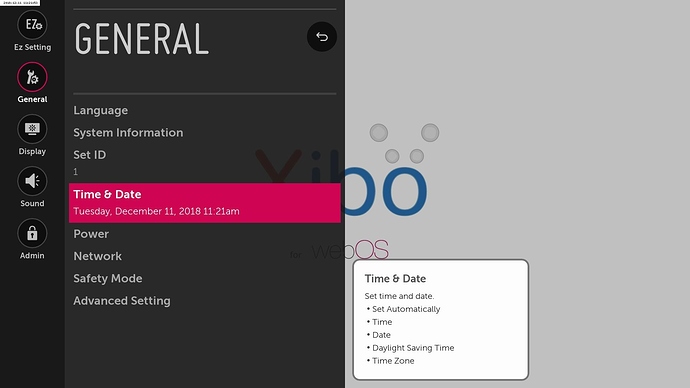
- Select Time & Date:
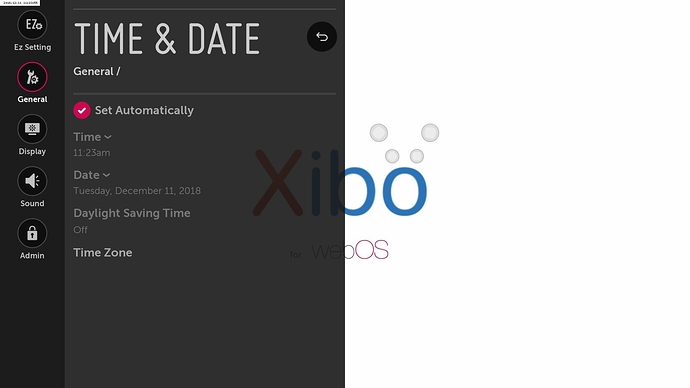
-
Use the drop down to select the correct Time and Date or alternatively ‘Set Automatically’.
-
Next, click on Time Zone:
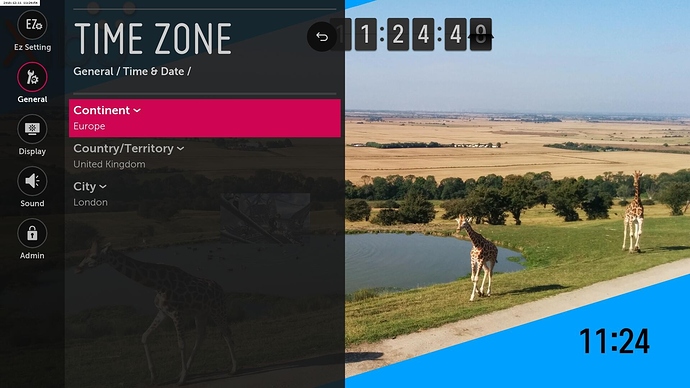
- Use the drop down to select the Continent, Country/Territory and City.
You can now proceed with the player installation steps!
Install the Xibo for webOS IPK
To install Xibo for webOS, you will need to access the Server or SI Server Settings, depending on the webOS version running on your monitor.
Please follow the appropriate instructions from the options below for the webOS version you are using.
Access Server Settings on webOS 3.0:
- From the remote control, press and hold the Settings button until a toast message appears in the upper right corner to notify that your input has been received.
- Enter 8080, and press the OK button to open the Settings Menu:
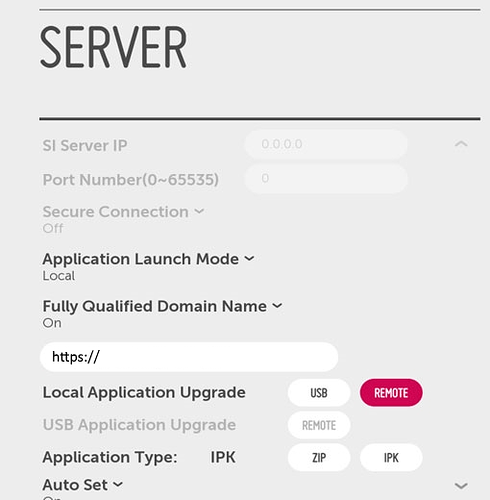
Access SI Server Settings on webOS 3.2 and later:
- On your remote control, press the Settings button.
- Choose the EZ Setting option.
- Select the SI Server Setting option.
- Then choose SI Server Setting again on the next page:
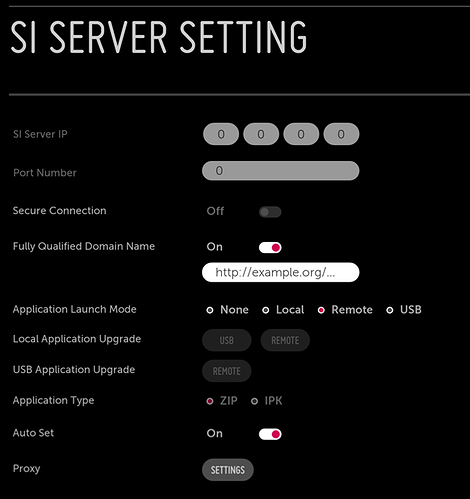
Installing the Player
From here, there are two methods for installing the player:
- Using Remote URL
or
- Using a USB flash drive
Remote URL
To remotely install the latest version of Xibo for webOS, set the fields on the Settings menu to the values provided below.

Option 1: Manually enter the settings:
-
Application Launch Mode - Local
-
Fully Qualified Domain Name - On
Enter the URL to your app package -
https://xibosignage.com/api/downloads/4/latest -
Application Type - IPK
-
Local Application Upgrade - REMOTE
Selecting this option will initiate the download of Xibo for webOS Player to your monitor. This should be the last field you complete.
Option 2: Auto-fill the Settings with USB-flash drive:
If you would rather configure these settings in a text file instead, then you can do so and install those on the monitor via USB flash drive with the following JSON file content:
{
"serverIp":"0.0.0.0",
"serverPort":80,
"secureConnection":false,
"appLaunchMode":"local",
"fqdnMode":true,
"fqdnAddr":"https://xibo.org.uk/api/downloads/4/latest",
"appType":"ipk"
}
-
Save the file as scap_installation.json.
-
Copy the JSON file into the root directory of a USB flash drive.
-
Insert the USB flash drive into the USB port of your monitor.
-
Turn on your monitor. The Server Settings defined in the
scap_installation.jsonfile will have been loaded onto the monitor automatically.When the installation is complete, please restart your monitor.
USB Installation
If you have a specific version of Xibo for webOS that you wish to install, or you do not have access to the internet to use the remote URL installation method, you can install the player locally via USB:
- Download the
ipkfile for the player version you want to use from here - Rename the downloaded
ipk, for example, Xibo_for_webOS_v2_R204.ipk to com.lg.app.signage.ipk and save it in the path specified below on your USB flash drive.
If this path does not exist on your USB flash drive, please create it: [USB_root]/application/com.lg.app.signage.ipk
-
Insert the USB flash drive into the USB port on your monitor.
-
Now access the Server Settings menu, as described earlier in this guide.
-
On the Settings menu, set the fields with the values provided below.
Application Launch Mode - Local Application Type - IPK Local Application Upgrade - USB

When the installation is complete, please restart your monitor to complete the installation.
Connect to your CMS
After installing the player and restarting your monitor, the Connect to CMS screen will appear.
Enter the following:
-
CMS URL: The fully qualified address of your CMS installation. For example
https://cms.example.org or http://example.org/cms -
CMS Key: The secret CMS Key that will authenticate this Display with the CMS.

This information can be entered manually, or by using one of our alternative methods listed below.
Automating CMS credentials entry using a USB stick
- Version R205 and earlier can auto populate CMS credentials credentials by preparing a JSON file.

Use Authentication code to connect to your CMS
If you are using a version 2 R205 Player or later, an additional option is available on the Connect to CMS page from CMS v2.0:
- Select the Use Code button to reveal a 6 digit key.
- Make a note of this code and log into your CMS.
- Go to the Displays menu in your CMS and click the Add Display (Code) button.
- Enter the code you received from your Player and click Save.
After a short wait, you should find that an entry for your Player will be created in your CMS.

Activate your Licence

-
If you have provided a Licence Pool Code as a Display Setting Profile, or as an entry on the Connect to CMS page, your Player will attempt to contact your license pool and acquire a licence.
-
If you have not provided a Licence Pool Code, a trial period will begin.
Your player will require a licence before the end of its trial period, or it will no longer receive scheduled events and media.
Display Setting Profiles
Default Profiles have been provided for you.

For more information on available settings, please see webOS Display Profile Settings and the Display Settings sections of the Manual.
Display Authorisation
Before the Player can receive Scheduled Events to display Layouts/Campaigns you will need to Authorise the Display to connect to the CMS.
-
Log in to the CMS and select Displays from the main CMS menu to see your newly registered Player in the list.
-
Use the row menu for the new Player and select Authorise from the drop down menu.
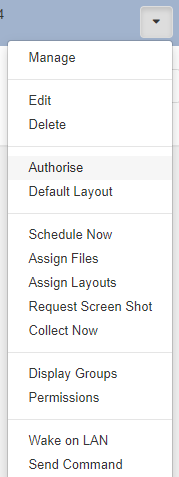
-
Click Yes to confirm the authorisation of the Display.




